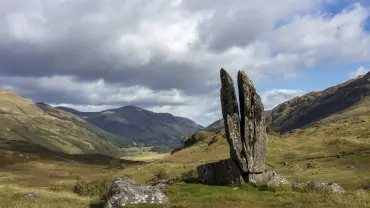In the mid-18th century, a shadow loomed over the French region of Gevaudan. The locals believed it was one cast not by man or nature, but by a monster that would become one of the most terrifying legends in French folklore.
Some blamed a wild animal, perhaps a wolf. Others believed it to be of supernatural origin. They called it the bete feroce, the ferocious beast, better known as the beast of Gevaudan. And its brutal attacks claimed more than 100 lives. So, what exactly was the Gevaudan Beast? Was it a creature of this world or another? We’re on the hunt for answers.
Birth of the Gevaudan Beast

Bronze statue of the Beast of Gevaudan by Philippe Kaeppelin (Credit: Andia via Getty Images)
In 1764, France was a country in the eye of an historical storm. Fresh from the losses of the Seven Years’ War, social and political unrest simmered, a precursor to the revolutionary fervour to come. It was in this torrid climate of uncertainty that a series of mysterious attacks began.
In the spring of that year, a young woman tended to her cattle in Gevaudan. This remote and rugged southern region was a quiet backwater, with a mix of dense forests and isolated farms. And it was in the Mercoire Forest that the woman described seeing a monster. It was larger than a wolf, with a wide chest, fearsome jaws, and reddish fur. Nobody knew it at the time, but this was the first recorded sighting of the beast of Gevaudan. And, while this victim escaped with her life, the next would not.
On 30 June 1764, the body of 14 year-old Jeanne Boulet was found in local woodlands. The shepherdess had been watching her flock when she was mauled by what was believed to be a wolf. While this event was both tragic and frightening, it did not stray far beyond the bounds of normality in 18th century Gevaudan. Wolf attacks were certainly not uncommon in this untamed landscape. It was only when the attacks continued that Boulet’s death was recognised as a grim beginning: the first fatality of the Gevaudan beast.
A Reign of Terror

Wooden depiction of the Beast of Gevaudan overlooking Saugues (Credit: Andia via Getty Images)
Between 1764 and 1767, over a hundred people were brutally attacked in Gevaudan and its surroundings. Their injuries were severe, including dismemberments and even decapitations. More than a hundred would die. And the legend of the Gevaudan monster grew, blending fact with folklore and fear.
The Hunt

The Beast of Gevaudan at the Court of Louis XV (Credit: Gwengoat via Getty Images)
Newspapers quickly picked up on the story, contributing to the growing legend with sensationalist reporting and spreading the details far beyond Gevaudan. It eventually drew the attention of none other than King Louis XV. The French monarch took action, sending professional wolf-hunters, soldiers, and even noblemen to hunt down the beast. And it was not just a mission to protect the people; it became a spectacle, drawing interest from across France and beyond. Yet, despite their efforts, the Gevaudan monster remained elusive, its attacks continuing with alarming regularity.
Monsters of the Gevaudan: Theories

Wolves in the Gevaudan Nature Park (Credit: Philippe Caron via Getty Images)
As the death toll attributed to the beast of Gevaudan rose, the theories surrounding its true nature diversified. What emerged was a cast of potential monsters of the Gevaudan, theories about which are still debated to this day.
The Giant Gevaudan Wolf Theory
One prevalent theory posits that the beast of Gevaudan was, in fact, an extraordinarily large and aggressive wolf. Proponents of the Gevaudan wolf theory point to historical accounts describing the beast’s appearance, which closely matches that of a wolf, albeit much larger and with distinctive features such as reddish fur and a daunting stature. This theory is supported by the fact that wolf attacks were not uncommon in 18th-century Europe, and wolves of significant size have been documented.
The Exotic Animal Hypothesis
Another suggestion was that the beast was an exotic animal, possibly a hyena or a lioness, brought to France from Africa or Asia. This hypothesis is fueled by accounts of the beast’s behaviour and physical characteristics, which some argue do not fully align with those of European wolves. Supporters of this theory also cite the presence of royal menageries and private animal collections that could have housed such creatures, raising the possibility of an escape or intentional release into the wild.
The Gevaudan Monster Hybrid Theory
A more speculative theory proposes that the beast of Gevaudan was a hybrid animal, resulting from the crossbreeding of a wolf and another species, possibly a large domestic dog or another wild canid. This theory seeks to explain the beast’s unusual size and strength, as well as its reported ability to withstand attacks that would have killed a normal wolf. The existence of such hybrids, while rare, has been documented in various parts of the world, lending some credibility to this hypothesis.
A Theory of Numbers
With the kills attributed to the beast spread over some 700 square miles, some think there was not one but several monsters of the Gevaudan region. For instance, there might have been a pack of wolves responsible for the carnage.
The Gevaudan Werewolf Explanation
Lastly, there are those who believe that the Gevaudan beast was of supernatural origin, a creature that transcends the natural world. The most popular of these is the Gevaudan werewolf theory, suggesting that the beast was a human who could transform into a wolf or wolf-like creature. This belief is deeply rooted in the folklore and superstitions of the time, which were rife with tales of werewolves and other shape-shifters. The werewolf theory was bolstered by the beast’s reported cunning and near-impossible ability to evade capture, traits that some argued could not be exhibited by a mere animal.
The End of the Beast

Wolves living on the legendary land of the Gevaudan (Credit: Patrick AVENTURIER via Getty Images)
The beast’s reign of terror seemingly came to an end in June 1767, when a farmer called Jean Chastel reportedly killed a large wolf-like creature during a hunt organised by the local nobility. The animal was said to match the descriptions of the beast, and its death led to a marked decrease in attacks. However, scepticism remained, with some questioning whether the true beast had been slain or if other monsters of the Gevaudan region still roamed.
Legacy and Cultural Impact

Engraving of the Beast of Gevaudan (Credit: Patrick AVENTURIER via Getty Images)
The story of the beast of Gevaudan has transcended its historical roots to become a legend that continues to fascinate and horrify. It has inspired countless books, films, and documentaries, each exploring the myriad aspects of this dark tale. Gevaudan itself embraced this legacy, with the tale of the beast attracting tourists from around the world, eager to explore the forests and villages that once lived in the shadow of the beast.
A Universal Tale

A reconstruction of the Beast of Gevaudan (Credit: ELLIOTT VERDIER/AFP via Getty Images)
The beast of Gevaudan remains one of France’s most enduring mysteries. It’s a story that captures the imagination, a blend of history and legend which speaks to the daunting fear of the unknown. The beast’s true nature, whether animal, man, or myth, may never be fully understood. Yet, the tale of the Gevaudan beast endures, a legendary nightmare that continues to haunt the collective memory of a nation.












